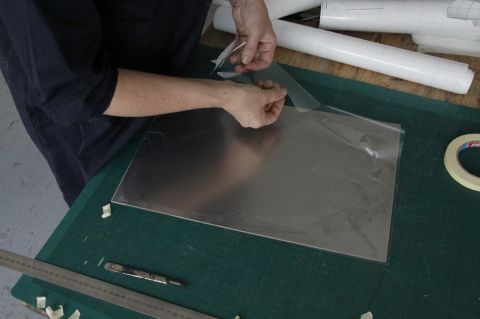Introductions.
There is a meeting arranged at the end of my second week with artists from Chisenhale Studios. This gives me a good deadline by which to produce my first trial prints. Before I start mass production I need to check that the techniques I am proposing will work and also try to invent shortcuts and efficiencies in order to save time later.
My initial idea is to print out photographs of the individual windowpanes and project them onto the plates with a Tracer Projector, then mask off the areas I don’t want to bite in the acid with sticky backed plastic. There are several problems with this. The first is that my studio is very light and being summer, stays light until past 9pm, which means I will have to carry out this fiddly process for all the plates in the middle of the night, or buy two large pieces of very good blackout material. Also, it is very time consuming, and results in a fuzzy image that leaves a lot to the imagination when transferring it to the plate. After transferring a couple of images this way I realise that it would be much easier to trace the photograph directly from the computer screen and then use the tracing as a template to cut the plastic before sticking it onto the plate. Fortunately my computer screen is just large enough for me to expand the photographs of each pane to exactly the same size as the plates, if I turn the images sideways.
I take 3 trial plates to the etching studio. I have not had that much experience of etching steel. Ian assures me that I can deep bite the steel for 20-30 minutes in 1:10 nitric acid and will get a deep black without the need for any aquatint, but I am worried that I will mistime it and end up with a drab grey. Also steel has a natural tooth unless polished, which results in a grey plate tone on the print, whereas with copper or zinc it would be almost white. So I could end up with everything in shades of grey. In addition I have never used plastic to mask off areas before, will it work, or will the acid seep under the edges? Why am I trying out so many new techniques on such a massive project with such a tight deadline?
The first print is a success. The black is incredibly black, the edges of the shape, sharp and glassy. I experiment with over-wiping the background with muslin to remove most of the plate tone and with leaving the plastic on the plate to print (the plastic has no plate tone, but does have scratches, which I quite like).
After the prints have dried I pin them up on the wall of Studio 4. I am excited. The voids have been given a black velvety form. They are figures now. They have come out as I wanted, but I am still surprised to meet them. When the artists from Chisenhale come to introduce themselves to me and to discuss their upcoming project to mark the 30th anniversary of their colonisation of the derelict factory, they form silhouettes against the window grid in the studio that echo the shapes in my prints.
This is why I like to make things: So they surprise and please me with their material presence and then I can watch as people and things interact with them.


